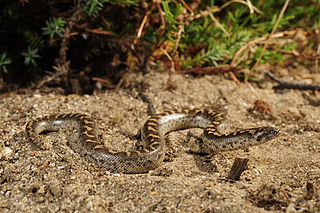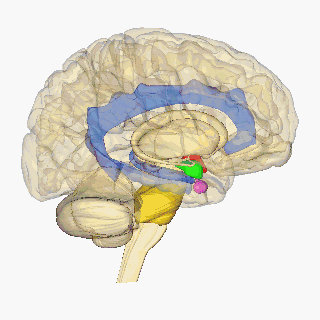
Aggression is a behavior aimed at opposing or attacking something or someone. Though often done with the intent to cause harm, it can be channeled into creative and practical outlets for some. It may occur either reactively or without provocation. In humans, aggression can be caused by various triggers. For example, built-up frustration due to blocked goals or perceived disrespect. Human aggression can be classified into direct and indirect aggression; whilst the former is characterized by physical or verbal behavior intended to cause harm to someone, the latter is characterized by behavior intended to harm the social relations of an individual or group.

A sexual fantasy or erotic fantasy is an autoerotic mental image or pattern of thought that stirs a person's sexuality and can create or enhance sexual arousal. A sexual fantasy can be created by the person's imagination or memory, and may be triggered autonomously or by external stimulation such as erotic literature or pornography, a physical object, or sexual attraction to another person. Anything that may give rise to a sexual arousal may also produce a sexual fantasy, and sexual arousal may in turn give rise to fantasies.

Infidelity is a violation of a couple's emotional and/or sexual exclusivity that commonly results in feelings of anger, sexual jealousy, and rivalry.
Sociosexuality, sometimes called sociosexual orientation, is the individual difference in the willingness to engage in sexual activity outside of a committed relationship. Individuals who are more restricted sociosexually are less willing to engage in casual sex; they prefer greater love, commitment and emotional closeness before having sex with romantic partners. Individuals who are more unrestricted sociosexually are more willing to have casual sex and are more comfortable engaging in sex without love, commitment or closeness.

Sociobiological theories of rape explore how evolutionary adaptation influences the psychology of rapists. Such theories are highly controversial, as traditional theories typically do not consider rape a behavioral adaptation. Some object to such theories on ethical, religious, political, or scientific grounds. Others argue correct knowledge of rape causes is necessary for effective preventive measures.
In-group favoritism, sometimes known as in-group–out-group bias, in-group bias, intergroup bias, or in-group preference, is a pattern of favoring members of one's in-group over out-group members. This can be expressed in evaluation of others, in allocation of resources, and in many other ways.
Sex differences in psychology are differences in the mental functions and behaviors of the sexes and are due to a complex interplay of biological, developmental, and cultural factors. Differences have been found in a variety of fields such as mental health, cognitive abilities, personality, emotion, sexuality, friendship, and tendency towards aggression. Such variation may be innate, learned, or both. Modern research attempts to distinguish between these causes and to analyze any ethical concerns raised. Since behavior is a result of interactions between nature and nurture, researchers are interested in investigating how biology and environment interact to produce such differences, although this is often not possible.

Parental investment, in evolutionary biology and evolutionary psychology, is any parental expenditure that benefits offspring. Parental investment may be performed by both males and females, females alone or males alone. Care can be provided at any stage of the offspring's life, from pre-natal to post-natal.
Sex differences in crime are differences between men and women as the perpetrators or victims of crime. Such studies may belong to fields such as criminology, sociobiology, or feminist studies. Despite the difficulty of interpreting them, crime statistics may provide a way to investigate such a relationship from a gender differences perspective. An observable difference in crime rates between men and women might be due to social and cultural factors, crimes going unreported, or to biological factors for example, testosterone or sociobiological theories). The nature or motive of the crime itself may also require consideration as a factor.

A psychological adaptation is a functional, cognitive or behavioral trait that benefits an organism in its environment. Psychological adaptations fall under the scope of evolved psychological mechanisms (EPMs), however, EPMs refer to a less restricted set. Psychological adaptations include only the functional traits that increase the fitness of an organism, while EPMs refer to any psychological mechanism that developed through the processes of evolution. These additional EPMs are the by-product traits of a species’ evolutionary development, as well as the vestigial traits that no longer benefit the species’ fitness. It can be difficult to tell whether a trait is vestigial or not, so some literature is more lenient and refers to vestigial traits as adaptations, even though they may no longer have adaptive functionality. For example, xenophobic attitudes and behaviors, some have claimed, appear to have certain EPM influences relating to disease aversion, however, in many environments these behaviors will have a detrimental effect on a person's fitness. The principles of psychological adaptation rely on Darwin's theory of evolution and are important to the fields of evolutionary psychology, biology, and cognitive science.

Sexual jealousy is a special form of jealousy in sexual relationships, based on suspected or imminent sexual infidelity. The concept is studied in the field of evolutionary psychology.
Shelley Elizabeth Taylor is an American psychologist. She serves as a distinguished professor of psychology at the University of California, Los Angeles. She received her Ph.D. from Yale University, and was formerly on the faculty at Harvard University. A prolific author of books and scholarly journal articles, Taylor has long been a leading figure in two subfields related to her primary discipline of social psychology: social cognition and health psychology. Her books include The Tending Instinct and Social Cognition, the latter by Susan Fiske and Shelley Taylor.

Sexual selection in humans concerns the concept of sexual selection, introduced by Charles Darwin as an element of his theory of natural selection, as it affects humans. Sexual selection is a biological way one sex chooses a mate for the best reproductive success. Most compete with others of the same sex for the best mate to contribute their genome for future generations. This has shaped human evolution for many years, but reasons why humans choose their mates are not fully understood. Sexual selection is quite different in non-human animals than humans as they feel more of the evolutionary pressures to reproduce and can easily reject a mate. The role of sexual selection in human evolution has not been firmly established although neoteny has been cited as being caused by human sexual selection. It has been suggested that sexual selection played a part in the evolution of the anatomically modern human brain, i.e. the structures responsible for social intelligence underwent positive selection as a sexual ornamentation to be used in courtship rather than for survival itself, and that it has developed in ways outlined by Ronald Fisher in the Fisherian runaway model. Fisher also stated that the development of sexual selection was "more favourable" in humans.
In sexual relationships, concepts of age disparity, including what defines an age disparity, have developed over time and vary among societies. Differences in age preferences for mates can stem from partner availability, gender roles, and evolutionary mating strategies, and age preferences in sexual partners may vary cross-culturally. There are also social theories for age differences in relationships as well as suggested reasons for 'alternative' age-hypogamous relationships. Age-disparate relationships have been documented for most of recorded history and have been regarded with a wide range of attitudes dependent on sociocultural norms and legal systems.
Anne C. Campbell was a British academic and author specializing in evolutionary psychology. Her research was largely concerned with sex differences in aggression between men and women. She was professor of psychology at Durham University.
Mate preferences in humans refers to why one human chooses or chooses not to mate with another human and their reasoning why. Men and women have been observed having different criteria as what makes a good or ideal mate. A potential mate's socioeconomic status has also been seen important, especially in developing areas where social status is more emphasized.

The neuroscience of sex differences is the study of characteristics that separate brains of different sexes. Psychological sex differences are thought by some to reflect the interaction of genes, hormones, and social learning on brain development throughout the lifespan. A 2021 meta-synthesis led by Lise Eliot found that sex accounted for 1% of the brain's structure or laterality, finding large group-level differences only in total brain volume. A subsequent 2021 led by Camille Michèle Williams contradicted Eliot's conclusions, finding that sex differences in total brain volume are not accounted for merely by sex differences in height and weight, and that once global brain size is taken into account, there remain numerous regional sex differences in both directions. A 2022 follow-up meta-analysis led by Alex DeCasien analyzed the studies from both Eliot and Williams, concluding that "the human brain shows highly reproducible sex differences in regional brain anatomy above and beyond sex differences in overall brain size" and that these differences are of a "small-moderate effect size" A review from 2006 and a meta-analysis from 2014 found that some evidence from brain morphology and function studies indicates that male and female brains cannot always be assumed to be identical from either a structural or functional perspective, and some brain structures are sexually dimorphic.

In evolutionary psychology and behavioral ecology, human mating strategies are a set of behaviors used by individuals to select, attract, and retain mates. Mating strategies overlap with reproductive strategies, which encompass a broader set of behaviors involving the timing of reproduction and the trade-off between quantity and quality of offspring.

The male warrior hypothesis (MWH) is an evolutionary psychology hypothesis by Professor Mark van Vugt which argues that human psychology has been shaped by between-group competition and conflict. Specifically, the evolutionary history of coalitional aggression between groups of men may have resulted in sex-specific differences in the way outgroups are perceived, creating ingroup vs. outgroup tendencies that are still observable today.
Female intrasexual competition is competition between women over a potential mate. Such competition might include self-promotion, derogation of other women, and direct and indirect aggression toward other women. Factors that influence female intrasexual competition include the genetic quality of available mates, hormone levels, and interpersonal dynamics.










